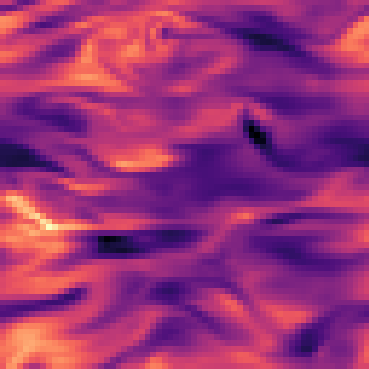|
--- |
|
language: |
|
- en |
|
license: cc-by-4.0 |
|
tags: |
|
- physics |
|
|
|
task_categories: |
|
- time-series-forecasting |
|
- other |
|
task_ids: |
|
- multivariate-time-series-forecasting |
|
--- |
|
|
|
This Dataset is part of <a href="arxiv.org/abs/2412.00568">The Well Collection</a>. |
|
|
|
# How To Load from HuggingFace Hub |
|
|
|
1. Be sure to have `the_well` installed (`pip install the_well`) |
|
2. Use the `WellDataModule` to retrieve data as follows: |
|
|
|
```python |
|
from the_well.benchmark.data import WellDataModule |
|
|
|
# The following line may take a couple of minutes to instantiate the datamodule |
|
datamodule = WellDataModule( |
|
"hf://datasets/polymathic-ai/", |
|
"MHD_64", |
|
) |
|
train_dataloader = datamodule.train_dataloader() |
|
|
|
for batch in dataloader: |
|
# Process training batch |
|
... |
|
``` |
|
|
|
# Magnetohydrodynamics (MHD) compressible turbulence |
|
|
|
**NOTE:** This dataset is available in two different resolutions \\(256^3\\) for `MHD_256` and \\(64^3\\) for `MHD_64`. The data was first generated at \\(256^3\\) and then downsampled to \\(64^3\\) after anti-aliasing with an ideal low-pass filter. The data is available in both resolutions. |
|
|
|
**One line description of the data:** This is an MHD fluid flows in the compressible limit (subsonic, supersonic, sub-Alfvenic, super-Alfvenic). |
|
|
|
**Longer description of the data:** An essential component of the solar wind, galaxy formation, and of interstellar medium (ISM) dynamics is magnetohydrodynamic (MHD) turbulence. This dataset consists of isothermal MHD simulations without self-gravity (such as found in the diffuse ISM) initially generated with resolution \\(256^3\\) and then downsampled to \\(64^3\\) after anti-aliasing with an ideal low-pass filter. This dataset is the downsampled version. |
|
|
|
**Associated paper**: [Paper](https://iopscience.iop.org/article/10.3847/1538-4357/abc484/pdf) |
|
|
|
**Domain expert**: [Blakesley Burkhart](https://www.bburkhart.com/), CCA, Flatiron Institute & Rutgers University. |
|
|
|
**Code or software used to generate the data**: Fortran + MPI. |
|
|
|
**Equation**: |
|
$$ |
|
\begin{align} |
|
\frac{\partial \rho}{\partial t} + \nabla \cdot (\rho \mathbf{v}) &= 0 \nonumber\\ |
|
\frac{\partial \rho \mathbf{v}}{\partial t} + \nabla \cdot (\rho \mathbf{v} \mathbf{v} - \mathbf{B} \mathbf{B}) + \nabla p &= 0 \nonumber\\ |
|
\frac{\partial \mathbf{B}}{\partial t} - \nabla \times (\mathbf{v} \times \mathbf{B}) &= 0 \nonumber\\ |
|
\end{align} |
|
$$ |
|
|
|
where \\(\rho\\) is the density, \\(\mathbf{v}\\) is the velocity, \\(\mathbf{B}\\) is the magnetic field, \\(\mathbf{I}\\) the identity matrix and \\(p\\) is the gas pressure. |
|
|
|
 |
|
|
|
| Dataset | FNO | TFNO | Unet | CNextU-net |
|
|:-:|:-:|:-:|:-:|:-:| |
|
| `MHD_64` | 0.3605 | 3561 |0.1798|**0.1633**| |
|
|
|
Table: VRMSE metrics on test sets (lower is better). Best results are shown in bold. VRMSE is scaled such that predicting the mean value of the target field results in a score of 1. |
|
|
|
# About the data |
|
|
|
**Dimension of discretized data:** 100 timesteps of 64 \\(\times\\) 64 \\(\times\\) 64 cubes. |
|
|
|
**Fields available in the data:** Density (scalar field), velocity (vector field), magnetic field (vector field). |
|
|
|
**Number of trajectories:** 10 Initial conditions x 10 combination of parameters = 100 trajectories. |
|
|
|
**Estimated size of the ensemble of all simulations:** 71.6 GB. |
|
|
|
**Grid type:** uniform grid, cartesian coordinates. |
|
|
|
**Initial conditions:** uniform IC. |
|
|
|
**Boundary conditions:** periodic boundary conditions. |
|
|
|
**Data are stored separated by ( \\(\Delta t\\)):** 0.01 (arbitrary units). |
|
|
|
**Total time range ( \\(t\_{min}\\) to \\(t\_{max}\\)):** \\(t\_{min} = 0\\), \\(t\_{max} = 1\\). |
|
|
|
**Spatial domain size ( \\(L_x\\), \\(L_y\\), \\(L_z\\)):** dimensionless so 64 pixels. |
|
|
|
**Set of coefficients or non-dimensional parameters evaluated:** all combinations of \\(\mathcal{M}_s=\\){0.5, 0.7, 1.5, 2.0 7.0} and \\(\mathcal{M}_A =\\){0.7, 2.0}. |
|
|
|
**Approximate time and hardware used to generate the data:** Downsampled from `MHD_256` after applying ideal low-pass filter. |
|
|
|
# What is interesting and challenging about the data: |
|
|
|
**What phenomena of physical interest are catpured in the data:** MHD fluid flows in the compressible limit (sub and super sonic, sub and super Alfvenic). |
|
|
|
**How to evaluate a new simulator operating in this space:** Check metrics such as Power spectrum, two-points correlation function. |
|
|
|
Please cite the associated paper if you use this data in your research: |
|
|
|
``` |
|
@article{burkhart2020catalogue, |
|
title={The catalogue for astrophysical turbulence simulations (cats)}, |
|
author={Burkhart, B and Appel, SM and Bialy, S and Cho, J and Christensen, AJ and Collins, D and Federrath, Christoph and Fielding, DB and Finkbeiner, D and Hill, AS and others}, |
|
journal={The Astrophysical Journal}, |
|
volume={905}, |
|
number={1}, |
|
pages={14}, |
|
year={2020}, |
|
publisher={IOP Publishing} |
|
} |
|
``` |
|
|